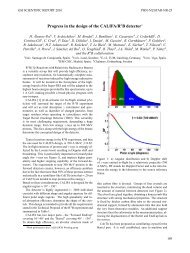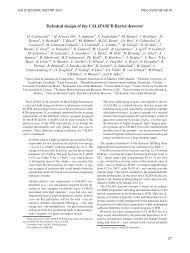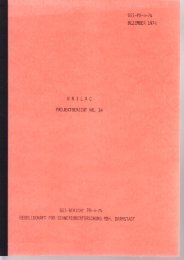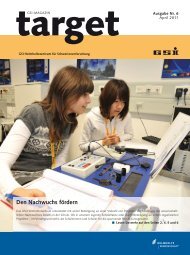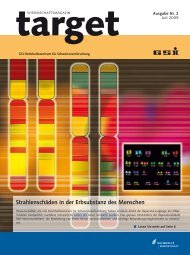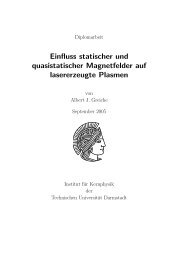download block - GSI Helmholtzzentrum für Schwerionenforschung
download block - GSI Helmholtzzentrum für Schwerionenforschung
download block - GSI Helmholtzzentrum für Schwerionenforschung
Create successful ePaper yourself
Turn your PDF publications into a flip-book with our unique Google optimized e-Paper software.
ACC-OTHERS-07 <strong>GSI</strong> SCIENTIFIC REPORT 2009<br />
Status report on the Frankfurt 200 mA proton source<br />
A remarkable progress on the 200 mA 120 keV high<br />
current proton source source for FRANZ (Frankfurt Neutron<br />
Source Source at the Stern Gerlach Centre) was achieved till end<br />
of 2009. Figure 1 1 shows a technical cross-section of the<br />
source. Principally, Principally, the source is composed of the Frankfurt<br />
Volume Volume Source Source plasma generator and equipped with<br />
a new pentode pentode extraction system. The plasma generator<br />
has a maximum input power power of 8 8 kW with a total total arc current<br />
of 100 A and an arc voltage voltage of 80 V. V. The plasma<br />
confinement is achieved by a solenoidal magnetic field<br />
with with a maximum flux density of 40 mT. Also included in<br />
the design is a filter magnet which generates generates a a transversal<br />
magnetic field field in front of emission aperture. aperture.<br />
Figure 1: Cross-section of the 200 mA proton source.<br />
The first measurements were performed for testing<br />
source characteristics and to evaluate the total beam current<br />
and the relative fraction of protons. An exemplary<br />
measurement can be seen in Figure 2.<br />
Figure 2: Measured beam fraction at a 25 mA total beam current.<br />
166<br />
<strong>GSI</strong>Template2007<br />
J. Sun 1 , W. Schweizer 1 , K. Volk 1<br />
J. Sun 1 , W. Schweizer 1 , K. Volk 1<br />
1<br />
IAP, Frankfurt, Germany<br />
A pentode extraction system has been designed for the<br />
FRANZ project with a single hole aperture of 5 mm radius.<br />
The application of a pentode extraction system enables<br />
not only decoupling of beam parameters from the<br />
beam energy but also allows a pulsed operation mode.<br />
With an optic fibre controlled high voltage switcher it is<br />
possible to adjust and optimize the repetition rate and<br />
pulse length to aim for a higher field strength resulting in<br />
higher peak current and less sparking between plasma and<br />
puller electrode. Furthermore, the pulsed operation mode<br />
relaxes the thermal loading for the whole extraction system<br />
and beam transport section. The operation time can<br />
be consequently extended. The very first pulsed beam is<br />
displayed in figure 3.<br />
voltage drop of 1 st stage [V]<br />
pulsed beam with thyristor stack 10Hz<br />
4500<br />
4000<br />
3500<br />
3000<br />
2500<br />
2000<br />
1500<br />
1000<br />
500<br />
0<br />
-0,05<br />
-0,3 -0,2 -0,1 0 0,1 0,2 0,3<br />
t [s]<br />
UEX 4,4kV<br />
2,2 mA<br />
Figure 3: Beam pulse from Frankfurt volume source in pulsed extraction<br />
operation mode.<br />
A reliable switch system has been interdisciplinary developed<br />
and successfully tested. Current beam sensor<br />
using parallel flux gating principle is chosen for comprehensive<br />
investigation on the pulsed beam. Intensive investigation<br />
on soft magnetic material for flux gate sensors<br />
has been accompanied. This helps for optimized operation<br />
parameters for detecting beam pulse [1] with sufficient<br />
resolution under current operation environment.<br />
Pulsed pentode extraction system opens new perspective<br />
in terms of operation mode extraction system, it<br />
brings also further topic with itself, which are relevant for<br />
a study of dynamic behaviour of plasma meniscus,<br />
sparking from Hz till kHz range, beam noise. All these<br />
topics associated with pulsed extraction mode will sustain<br />
more innovative development of extraction system.<br />
[1] B-J. Lee et al.: “Properties of magnetic materials at very high magnetization<br />
rates”.<br />
0,3<br />
0,25<br />
0,2<br />
0,15<br />
0,1<br />
0,05<br />
0





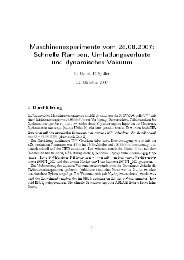
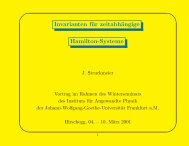
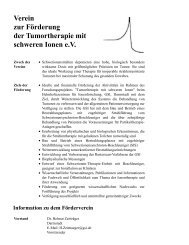
![GS I -P-]-17 - GSI Helmholtzzentrum für Schwerionenforschung](https://img.yumpu.com/20698964/1/184x260/gs-i-p-17-gsi-helmholtzzentrum-fur-schwerionenforschung.jpg?quality=85)

